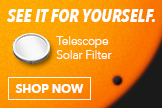NASA Satellites to Beam Back Images of Rare Mercury Transit in Real-Time
Even if you can't find a solar telescope to watch the Mercury transit on Monday (May 9), you don't have to miss the action: NASA will have three satellites watching the planet pass across the face of the sun, with one satellite providing nearly real-time imagery to skywatchers online.

Mercury will make its way across the sun from Earth's point of view between 7:12 a.m. and 2:42 p.m. EDT (1112 to 1842 GMT) and should only be viewed with binoculars or a telescope and a solar filter. (Projecting the sun's image through a pinhole will not work because Mercury is so small on the sun's surface, making it invisible.)
For those without access to those tools, a near-real-time feed of images will be available throughout the event at nasa.gov/transit.
Mercury transits are rare because Mercury's orbital plane is tilted with respect to Earth's orbit. The two planets align perfectly only about 13 times a century. When a transit does happen, scientists can use the information to fine-tune their knowledge about how planets and stars move in space. [The Mercury Transit of 2016: Full Coverage]
During Monday's transit, the Solar and Heliospheric Observatory (SOHO), which is operated by NASA and the European Space Agency, will measure the sun's rotational axis using two instruments that have been shut off for five years but will be turned back on to witness the event: the Extreme ultraviolet Imaging Telescope and the Michelson Doppler Imager.

Meanwhile, NASA's Solar Dynamics Observatory (SDO) will align its instruments using the transit. This is possible because scientists know so precisely where Mercury is supposed to be in relation to the sun. Researchers will also compare SDO measurements of the transit with SOHO's.
"Instruments on board SDO and SOHO use different spectral lines, different wavelengths, and they have slightly different optical properties to study solar oscillations," SOHO project scientist Joseph Gurman said in a statement. "Transit measurements will help us better determine the solar rotation axis."
Get the Space.com Newsletter
Breaking space news, the latest updates on rocket launches, skywatching events and more!
NASA, along with several other space agencies, will also observe the transit using Japan's Hinode satellite. Hinode is led by the Japanese Aerospace Exploration Agency (JAXA) and is used in collaboration with NASA, the European Space Agency and the U.K. Space Agency.
The first telescope observation of a Mercury transit occurred in 1631, NASA officials said in the statement. At the time, it showed astronomers how big Mercury's disk appeared and also helped them figure out the distance between the Earth and the sun.
Editor's note: Visit Space.com on Monday to see live webcast views of the rare Mercury transit from Earth and space, and for complete coverage of the celestial event. If you SAFELY capture a photo of the transit of Mercury and would like to share it with Space.com and our news partners for a story or gallery, you can send images and comments in to managing editor Tariq Malik at spacephotos@space.com.
Follow Elizabeth Howell @howellspace, or Space.com @Spacedotcom. We're also on Facebook and Google+. Original article on Space.com.
Join our Space Forums to keep talking space on the latest missions, night sky and more! And if you have a news tip, correction or comment, let us know at: community@space.com.

Elizabeth Howell (she/her), Ph.D., was a staff writer in the spaceflight channel between 2022 and 2024 specializing in Canadian space news. She was contributing writer for Space.com for 10 years from 2012 to 2024. Elizabeth's reporting includes multiple exclusives with the White House, leading world coverage about a lost-and-found space tomato on the International Space Station, witnessing five human spaceflight launches on two continents, flying parabolic, working inside a spacesuit, and participating in a simulated Mars mission. Her latest book, "Why Am I Taller?" (ECW Press, 2022) is co-written with astronaut Dave Williams.









